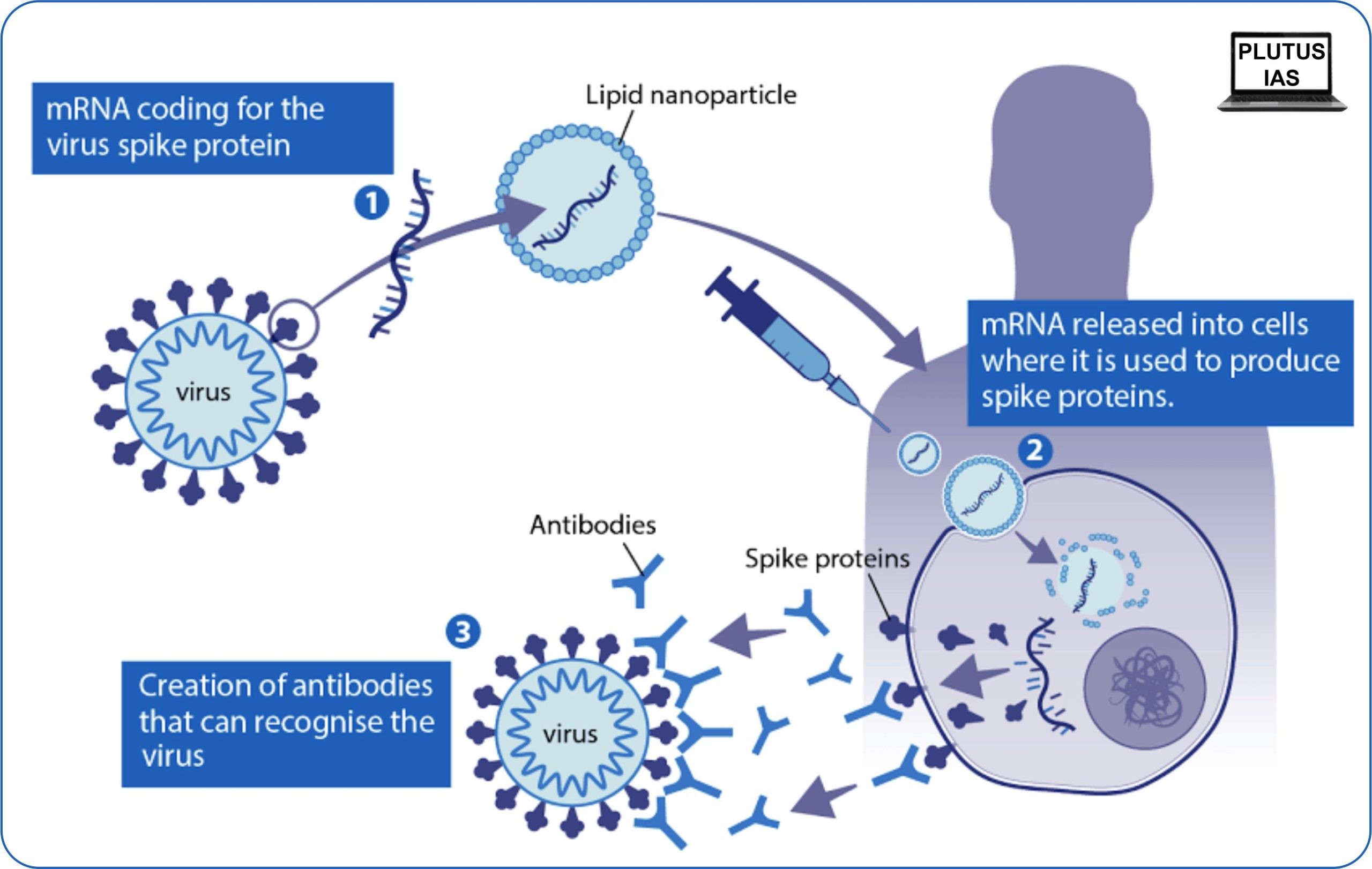04 Oct mRNA Vaccines
This article covers “Daily Current Affairs” and the topic details “mRNA Vaccines”. This topic has relevance in the “Science and Technology” section of the UPSC CSE exam.
For Prelims:
What are mRNA Vaccines?
For Mains:
GS3: Science and Technology
Why in the news?
Katalin Karikó and Drew Weissman have won the 2023 Nobel Prize in Medicine for their vital contributions to mRNA vaccine development, especially for COVID-19 during the 2020 pandemic.
mRNA Vaccines
- mRNA vaccines, short for messenger RNA vaccines, refer to vaccines that use genetic material called messenger RNA to activate the immune system and produce antibodies against specific infections.
Working of mRNA
- Making of mRNA Vaccine:
-
- mRNA vaccines work by introducing a small piece of mRNA that carries the genetic instructions to produce a viral protein, usually the spike protein found on the virus’s surface.
- The mRNA is encapsulated in lipid nanoparticles to protect it and help deliver it into cells.
- Protein Production:
- Once inside the body’s cells, the mRNA serves as a template for protein synthesis. This mechanism is known as the Translation of genetic code.
- The cells use this genetic information to produce the viral protein, in this case, the spike protein of the virus. This protein is then displayed on the surface of the cells, triggering an immune response.
- Immune Response:
- The presence of the viral protein alerts the immune system, which recognises it as foreign and mounts an immune response.
- This response includes the production of antibodies that can recognise and neutralise the virus if the person is later exposed to it.

Advantages:
- Rapid Development: mRNA vaccines can be developed quickly, making them ideal for responding to outbreaks or pandemics.
- Flexibility and Adaptability: The mRNA sequence in these vaccines can be easily modified to address new variants or strains of a virus.
- Safety: mRNA vaccines are safe as they do not use live viruses or integrate into the recipient’s DNA.
- No Risk of Integration into DNA: These vaccines are transient and do not alter an individual’s genetic material.
- Strong Immune Response: these vaccines stimulate a robust immune response, generating specific antibodies and activating T cells.
- Scalability and Production: Large quantities of these vaccines can be manufactured efficiently, allowing mass production and distribution.
- Potential for Wide Application: mRNA technology can be used in areas beyond infectious diseases, such as cancer immunotherapy.
Challenges Associated:
- The manufacturing process for mRNA vaccines can be complex and time-consuming, requiring advanced techniques to improve efficiency.
- These vaccines require strict cold storage conditions, posing distribution and storage logistics challenges.
- Vaccine hesitancy and public perception can be challenging with mRNA vaccines, requiring effective communication and education.
- The cost of mRNA vaccine development, production, and distribution can be higher than traditional vaccine technologies, affecting equitable access in low-income countries.
Contributions of Karikó and Weissman
- Karikó and Weissman made a significant breakthrough in the field of mRNA research. They found that when lab-grown mRNA is used for vaccines or therapies, the body’s immune cells see it as foreign and trigger inflammation.
- To study this, they created modified versions of mRNA with chemical changes and tested them on immune cells. They discovered these modifications reduced inflammation, making mRNA more suitable for medical use.
- Their findings, published in 2005, were a significant advancement, laying the groundwork for future mRNA applications, including COVID-19 vaccines.
Download plutus ias current affairs eng med 4th Oct 2023
Q1. With reference to mRNA vaccines, consider the following statements:
- These vaccines require the integration of the viral protein into the recipient’s DNA.
- These vaccines stimulate a robust immune response, generating specific antibodies and activating T cells.
- These vaccines stimulate a robust immune response, generating specific antibodies and activating T cells.
Which of the statements given above is/are correct?
(a) 1 and 2 only
(b) 2 and 3 only
(c) 3 only
(d) None
Q2. Which mechanisms serve as a template for protein synthesis in mRNA vaccines?
(a) Reverse transcription
(b) Transcriptional regulation
(c) Translation of genetic code
(d) Post-translational modification
Q3. Discuss the working mechanism of mRNA vaccines and their advantages in the context of responding to infectious disease outbreaks. How do these vaccines differ from traditional vaccine technologies?




No Comments